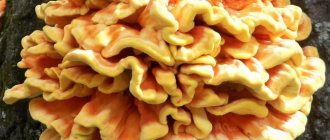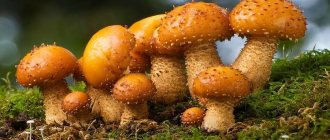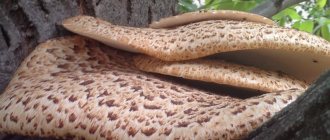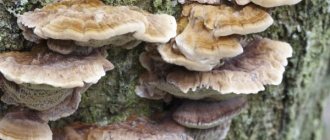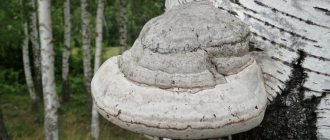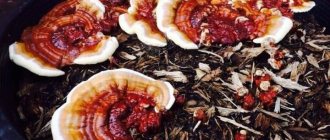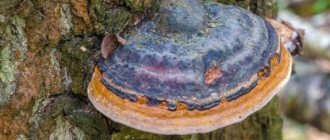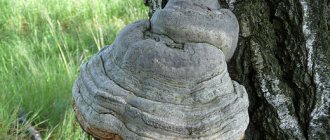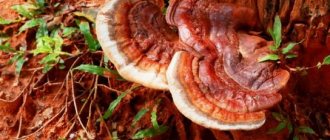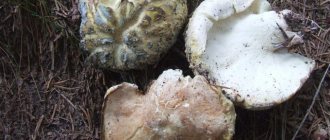Description and characteristics of a conditionally edible mushroom
The scaly tinder fungus is also called the motley tinder fungus, the variegated tinder, the hare, and the elm. Latin names: Cerioporus squamosus, Polyporus squamosus, Melanopus squamosus, Polyporellus squamosus. The mushroom belongs to the Polyporaceae family, genus Cerioporus and is conditionally edible.
The Tinder fungus is essentially a parasite that feeds on tree sap. It penetrates weakened trunks in the form of spores and grows there, forming a mycelium.
The cap has the shape of a kidney; as the fetus matures, it becomes flat and spread out. It can reach 30 cm in diameter. It is very fleshy and thick, and may be slightly depressed at the base.
The surface is leathery, yellow in color, covered with dark brown scales. The scales are placed on its surface in symmetrical circles. The edges are fan-shaped and thin. The caps on the fruiting bodies are arranged like tiles.
Hymenophore - the lower part of the cap, tubular, yellowish in color. The tubular layer has large angular pores.
The pulp is juicy, dense, whitish-cream in color, and has a pleasant aroma, similar to the smell of half-baked baked goods; sometimes the smell emitted by the mushroom is reminiscent of honey. In old pieds, the flesh becomes woody.
The tinder fungus has a thick lateral leg, which is sometimes eccentric. Its width can reach four centimeters, and its length can reach ten. The surface of the leg, like the cap, is covered with brown scales, the base is darker, and the lower part is lighter, with a mesh pattern.
Appearance
Chicken Mushroom: appearance
Initially, the Chicken Mushroom looks like a large influx of viscous liquid, yellow-orange in color, breaking through the bark; with age, the tinder fungus takes the form of an enfilade of pseudo-caps fused together like a fan, usually sitting on one base, less often single. The diameter of the caps ranges from 10 to 40 cm, their edges are wavy and divided into separate lobes. The thickness of the mushroom near the tree trunk can reach 7 cm, and the weight of the entire fruiting body sometimes reaches 10 kg. The top of the mushroom is often covered with a light yellow-cream fluff.
Tubular-type plates with small or jagged pores.
The pulp is yellowish-white, brittle and juicy, soft and sour in taste. Young specimens have a pleasant smell of freshness with a lemon tint, while older specimens have a stale smell, and the flesh itself becomes woody and pale.
The color of the Chicken Mushroom changes with age from pale yellow to orange or pinkish orange, often the edges of the caps are lighter than the middle.
What trees do they grow on? Time and place of fruiting
These mushrooms settle on weakened old trees. The scaly polypore can be found both in forests and parks. Grows on old maples, acacias and poplars.
At the same time, it is on maple that it collects the most nutrients. On acacias, tinder fungi are most often small and tough. You can also often find the haretail on elms. Causes the development of white and yellow rot on trees.
Polypores grow singly or in groups and usually low on a tree - 10–12 meters from the ground. But they can also grow almost in the ground. Sometimes they form small colonies in the form of fan-shaped clusters. They bear fruit from May to August.
Which tinder fungi can be eaten
There are many varieties of tinder fungi. They are divided into inedible, conditionally edible, medicinal and edible.
The following varieties can be used for preparation:
- Sulfur yellow. It belongs to the category of conditionally edible, since only young specimens that do not have dark spots can be eaten.
- Scaly. Used in medicine, dried, pickled and added to sauces and soups. This species grows primarily on elms.
- Liverwort. It grows on oak trees, young mushrooms are pickled or pickled.
- Umbrella. Resembling large bouquets, this variety of mushrooms is popular in China as a main dish.
- Winter. Grows on the trunks of alder, birch or willow. The pulp is suitable for consumption.
- Sheep. The only variety that is similar in appearance to a “normal” mushroom. Used as a basis for water and alcohol infusions. It can also be dried, pickled or salted.
Scaly tinder fungus can be dried, pickled and added to sauces and first courses
Important! Before going into the forest, you need to carefully study photographs of tinder fungi so as not to confuse an edible species with a poisonous one.
Growing at home and in the country
The scaly tinder fungus can be easily grown independently both at home and in the country. To do this, you will need a substrate of sawdust, shavings and branch bark. The growing process consists of the following stages:
- Pour boiling water over the substrate and wait until it cools to room temperature.
- Squeeze the resulting mixture and place the wet substrate in a plastic bag, adding the mycelium.
- Make a cut on the bag and leave it in a room where the humidity is at least 70–80% and the temperature is maintained at +20 degrees.
- The first harvest will appear in 30–40 days.
The substrate on the site can be hemp or bars. You need to make cuts in them with any convenient hand tool. Place the mycelium into the cuts. The substrate must contain a sufficient amount of moisture, so it should also be soaked in water first.
Important! Growing tinder fungus on your own can be considered advisable, since the fungus gives quick harvests and can be used both for culinary purposes and as a medicinal component in the menu.
Use for weight loss
Wood polypore speeds up metabolic processes and helps you lose excess weight faster. On a diet, it is useful to use the following remedy:
- birch mushroom is crushed in the amount of 5 g;
- pour pieces or fine powder into 100 ml of hot water at about 80 °C;
- keep covered for a quarter of an hour and filter.
The product is taken completely chilled three times a day directly with meals. The course must be continued for two months.
The use of birch polypore on a diet should be combined with a healthy diet and exercise.
False doubles of polyporus
The tinder fungus, like most mushrooms, has false doubles. The differences between these species can be most clearly seen in the photo.
Polypore honeycomb
Liver mushroom
The cellular polypore is an edible relative of the scaly polypore. The difference lies in the brighter color of the cap - in the cellular tinder fungus it is reddish-orange. Also, this mushroom, even at a young age, has a very hard fruiting body; the flesh of the cellular tinder fungus has a very faint odor and an inexpressive taste.
Liver mushroom is edible, with a delicate taste and a strong sour taste. It usually grows in the lower part of the trunk or at the roots. It is distinguished by an unusually bright color of the pulp, reminiscent of meat with whitish veins.
Dangerous doubles are clearly described in the table:
| Tinder fungus | The color of the mushroom cap ranges from bright red to brown. The fruiting body is sessile, fan-shaped. It most often grows in groups, bears fruit throughout the year on fallen trunks of deciduous trees and old stumps, most often on willows. |
| Sulfur-yellow tinder fungus | It cannot cause direct harm to health. But due to its sharp, bitter, unpleasant taste and disgusting smell, it can cause stomach cramps caused by pronounced individual intolerance. |
Methods for storing mushrooms
Mushrooms are undoubtedly a very tasty and nutritious product. But we shouldn’t forget about the danger. When preparing mushrooms for the winter, you need to choose methods that ensure complete sealing of the container. Some housewives simply fry mushrooms (even without using salt!), put them in glass jars and pour oil over them. This is a bad option: as a result of fat oxidation, the mushrooms will taste unpleasant. And that's not the worst part! It's easy to get seriously poisoned by these mushrooms. After all, a layer of oil and the absence of oxygen is a favorable environment for the growth of spores of botulinus microbes, which produce a deadly poison. You should know that these spores cannot be completely eliminated by washing, boiling or frying. Some of them will still remain on the mushrooms placed in the jar. The whole task is not to provoke their activation. To do this, you need to carefully monitor the sterility of containers and lids. Otherwise, botulism cannot be avoided.
Safe ways to store mushrooms:
1) Frozen mushrooms should be stored in the freezer in cling film bags. At the same time, it does not matter by what technology they were frozen: fresh or pre-cooked. Freezing allows you to preserve the taste and beneficial properties of mushrooms for 12 months. That is, there should be enough reserves until the start of the new season.
2) Dried mushrooms also retain all vitamins and microelements, but are quite capricious in terms of conditions. They should be kept in paper or fabric packaging in a dry, well-ventilated and not too cold room. It is also worth remembering that dried mushrooms perfectly absorb extraneous aromas, so it is recommended to store them separately from garlic, onions, seasonings and spices. On average, dried mushrooms can be used without health concerns for two years. Just keep in mind that with a long shelf life, the amount of protein in them decreases.
3) Pickled mushrooms must be stored in the underground, cellar, refrigerator or basement, that is, in a fairly cold place and protected from light. The container should only be glass, and the lids should be metal (with a food coating to protect the contents, otherwise the risk of poisoning increases many times) or also glass. They should fit snugly to the can and not let air in from the outside. With glass lids, marinades are stored longer - up to two years, while metal limits this period to only a year. This fact is understandable: the contents of the jar react to metal much faster than to glass. That is, the mushrooms begin to release life-threatening toxins; eating such canned food is strictly not recommended.
4) Salted mushrooms can be kept in various containers. For example, an oak barrel, an enamel pan or a glass jar. To preserve the product, pressure is necessary. The mushrooms must be completely immersed in liquid (brine). The best place to store mushroom pickles is a cellar or refrigerator, and the optimal temperature is from +5 to +6 degrees. Even sub-zero temperatures are not scary for them, so jars of mushrooms are often placed directly on the balcony. But you should always remember that mushrooms prepared using this method spoil very quickly. Therefore, you need to eat them quickly, before the lovingly made preparations become covered with nasty mold. Well, don’t salt too many mushrooms.
5) Mushroom caviar is stored in a cool place and in sterile glass containers. This delicacy is easy to prepare. It is fried in oil until the liquid has completely evaporated and immediately, without waiting for it to cool, it is laid out in containers. Hot vegetable oil is poured on top and the lids are closed. Then the jars need to be sterilized. A metal dish with a fairly wide neck (for example, a saucepan or a bowl with high sides) is suitable for this. You need to put a cloth napkin on the bottom, pour hot water, put jars of caviar in it and add more water so that its level reaches the level of the caviar. Then bring the liquid to a boil. Sterilization time depends on the volume of the container. For example, five minutes is enough for a half-liter jar, but a liter container must be sterilized for at least ten minutes. Then the lids are tightly screwed on, and the jars of caviar are sent to cool in a warm place. You don’t have to sterilize mushroom caviar, but then you can keep it exclusively in the refrigerator. This product also withstands the harsh conditions of the freezer well. But this option has its own subtleties: add just a little salt (a teaspoon for five liters) and put it in a plastic container, which, unlike glass, is not afraid of low temperatures.
6) For mushroom powder, a sealed container made of metal or glass is best suited - the humidity levels in it do not change, so the powder will retain its beneficial properties and mushroom taste for a long time without foreign impurities. This type of workpiece “loves” darkness, humidity not higher than 75% and air temperature of 18° - 20°C. Wrapping paper with an additional layer of parchment, laminated paper or cellophane are slightly less suitable for storing powder. In them, the moisture content of the powder changes over time. For example, after four months it increases by 15-30%, and after six months of storage it decreases again by 13-16%.
Summary
So, there are several technologies for preserving mushrooms, but those that involve sterilization of the container and its contents are safer. In addition, with this processing, mushrooms retain their nutritional value and even acquire a particularly pleasant taste and aroma. Mushroom preparations are a great way to expand your winter menu and enrich your diet with proteins, amino acids, vitamins and other healthy substances. So picking mushrooms in the summer and trying to preserve them is a wise and far-sighted decision.
Medicinal properties and contraindications, benefits and possible harm
Eating polyporus helps restore the body after poisoning with poisons and heavy metals. Also, the beneficial properties of this mushroom are recognized by official medicine and medicines are made on its basis that help remove toxins and heavy compounds from the body.
In particular, “Milife” is a parapharmaceutical of plant origin, which is a biomass of a lyophilisate of a monoculture of the tinder fungus.
Thanks to the richest set of useful substances, the drug restores physiological phagocytosis in the body. The indicators of redox potential are normalized.
The mushroom has antiseptic, hemostatic, anti-inflammatory effects. It is often used to create diets, restore metabolism and treat functional disorders.
Increases immunity, accelerates the breakdown of fats and prevents the formation of adipose tissue. Able to stabilize blood sugar levels.
In folk medicine, powders and ointments are made based on Tinder fungus to combat nail fungus.
Along with many useful properties, the hare also has contraindications:
- Polyporus scaly in various dishes, as well as as part of medications, is not recommended for pregnant and lactating women.
- It will negatively affect the condition of people suffering from urolithiasis.
- Individual intolerance can manifest itself in the form of an allergic rash.
Important! Before using drugs based on tinder fungus, you should definitely consult your doctor.
Methods of preparation and use
Traditional medicine uses the pulp of the birch polypore to prepare several medicines. They can be used externally and internally.
Tincture of birch polypore
An alcoholic tincture of tree mushroom is beneficial for nervous disorders and sleep disorders. It is made according to this recipe:
- dry tinder fungus is ground to a powder in an amount of 200 g;
- pour 500 ml of high-quality vodka into the raw material;
- seal the vessel and put it in a dark place for three days;
- strain the medicine from the sediment.
We recommend reading: Clove essential oil: properties and uses
Take the finished tincture one small spoon an hour before going to bed. The course of treatment must be continued for three weeks.
Birch polypore tincture is suitable for rubbing joints for arthritis and rheumatism
Infusion
For cardiovascular ailments and intestinal diseases, you can take a water infusion of tree mushroom. The recipe for preparing the product looks like this:
- dry mushroom is crushed in the amount of two small spoons;
- pour the resulting powder into 200 ml of hot clean water;
- closed, leave to infuse for two days;
- After time, filter the product and pour it into a new container.
You need to take the infusion 15 ml three times a day on an empty stomach.
It is not recommended to brew birch polypore in boiling water, as this destroys the beneficial substances in the composition.
Powder
One of the recipes for using birch tinder fungus recommends using dry fruiting body powder. Medicinal raw materials disinfect damage and promote rapid skin restoration. Wounds and ulcers are washed with peroxide or alcohol, and then sprinkled with mushroom powder and a sterile bandage is applied on top.
Evaluation of taste qualities, simple and tasty recipes for cooking
Young fruiting bodies of the tinder fungus can be eaten; they are assigned the fourth category of edibility.
Old Polyporus are not suitable for food as they become very tough. Timely collected and properly prepared mushrooms have excellent taste.
Primary processing
After collecting the tinder fungus, you need to soak it as quickly as possible, otherwise it will begin to become woody. You need to soak for at least six hours, ideally for a day. The water must be changed frequently. During the day - every hour.
After soaking, peel off the top skin in the form of scales and cut off the legs, as they are very hard. Cut off the dense parts of the mushroom, which are usually located near the stem.
Cooking
Before any further cooking, the mushroom must be boiled for half an hour. For 500 grams of forest fruits you should take three liters of water. The strained broth can be used to make soup.
Important! Undercooked tinder fungi are tough and sweet, and the sweetness cannot be overcome even by spices.
Pickling
For preparation you will need:
- 0.5 kg of boiled mushrooms;
- 80 g apple cider vinegar 5%;
- 120 g vegetable oil;
- 2–3 cloves of garlic;
- 10 black peppercorns;
- 1 tsp. salt;
- 2 tsp. Sahara;
- 4 things. bay leaf.
Cooking process:
- Press the garlic through a press.
- Place all ingredients in a deep frying pan, cover with a lid and place over medium heat and simmer for 10 minutes.
- Cool, transfer to a jar and refrigerate for 4 hours.
Freezing
Blot the prepared boiled mushrooms with a napkin, removing excess moisture. Place in small containers of 100-300 grams. Place in the freezer and use as needed.
Frying
Ingredients:
- mushrooms – 500 g;
- onions – 2 pcs.;
- vegetable oil – 3 tbsp;
- dill and parsley – 50 g;
- salt, pepper - to taste.
Preparation:
- Boil the mushrooms.
- Cut the onion into quarter rings.
- Heat vegetable oil in a frying pan and fry the vegetable in it until it becomes transparent.
- Once the onion has reached the desired state, add boiled mushrooms to the frying pan and fry over medium heat for 10-15 minutes.
Salting for the winter
Ingredients:
- mushrooms – 3 kg;
- table salt – 120 g;
- dill (greens, inflorescences or seeds) - to taste;
- black pepper – 30-35 peas;
- bay leaf – 6 pcs.;
- garlic – 4–5 cloves.
Pre-boiled mushrooms are placed in a pickling container with all other ingredients in the following order:
- Place bay leaf, chopped garlic and dill, as well as black pepper on the bottom.
- Spread the mushrooms on the spices in a layer of about 7 cm and sprinkle with salt.
- Add a few more layers to the edge of the container.
- Cover the workpiece with a napkin, place a weight on top and put it in a dark place for a month.
- After the required time, the mushrooms will be ready to eat.
Drying
How to dry bunnies:
- Wipe the tinder fungi with a damp cloth, thoroughly removing soil and any other contaminants.
- Cut into medium sized pieces.
- Thread on a thread so that the pieces do not touch each other.
- Hang to dry outdoors in a sunny place.
- You can cover it with gauze so that insects do not have access to the mushrooms.
Tinder cutlets
Ingredients:
- mushrooms – 500 g;
- white loaf – 4 slices;
- onions – 2 pcs.;
- vegetable oil – 150 g;
- wheat flour – 130g;
- chicken egg – 1 pc.;
- garlic – 2 cloves;
- salt, pepper - to taste.
Preparation:
- Pass the prepared boiled mushrooms through a meat grinder with a fine wire rack 2-3 times.
- Soak the loaf slices in water for 7–10 minutes.
- Grind the onion and garlic in a meat grinder.
- Combine prepared products with egg, salt and spices.
- Form cutlets, roll them in flour and fry in vegetable oil on both sides.
How to cook tinder
Before you start cooking the tinder fungus, it needs initial heat treatment for 40-45 minutes. After this, you can begin the cooking process:
- Cooking. The most important manipulation before further actions. Boil the mushrooms in lightly salted water for about an hour, after which the liquid is drained.
- Frying. Boiled tinder fungi are fried in sunflower oil for 10 minutes. If necessary, add sauce or spices, and it all simmers under the lid for another 10-15 minutes.
These are the main preparation steps - the remaining steps will depend on the chosen recipe.
Interesting facts about the beneficial and healing mushroom
At first, the name Scaly tinder fungus was given to another mushroom - small, covered with small scales. But later it was reclassified as the tuberous tinder fungus.
The scaly polypore is a universal mushroom that has found successful use in cooking and medicine. Excellent for all types of preparations; as a semi-finished product it is capable of not losing useful substances even after long-term storage in the refrigerator.
Information sources
Lyubarsky L.V., Vasilyeva L.N. Scaly polypore // Wood-destroying mushrooms of the Far East. — Novosibirsk: Science, 1975
Selection and preparation of ingredients
The sulfur-yellow tinder fungus is considered a good conditionally edible mushroom. This means that it requires pre-treatment before cooking - it should be soaked for a couple of hours in cold water and then boiled for 40-50 minutes.
Important! Old mushrooms should not be used in cooking. Hard, greyish, pale specimens with an unpleasant odor are unsuitable for food.
Only young mushrooms with a pleasant smell, sour taste, and soft structure are suitable for consumption. They need to cut out the part adjacent to the tree.
Fruiting body of tinder fungus
The fruiting bodies of tinder fungi, unlike cap mushrooms, are long-lived.
Their anatomical structure is quite simple - they consist entirely of hyphae, of which there are three main types: generative, skeletal and connecting.
According to their shape, the fruiting bodies of tinder fungi can be divided into the following main categories: prostrate, sessile and differentiated into a cap and a stalk.
But there are various transitions between them, and within the boundaries of the first family and even genus, fruiting bodies of various shapes can be observed.
Differences in the fruiting bodies of the tinder fungus
The prostrate fruiting bodies of polypores have the appearance of a film or plate, more or less adherent to the substrate and repeating the features of its surface.
The edge of such a fruiting body can be tightly adherent and disappearing, or raised in the form of a thick ridge. From time to time, its fusion with the substrate is loose, and when it dries, the edge bends and curls up.
Sessile fruiting bodies have a hoof- or cantilever-shaped, sometimes tongue-like shape, and are attached by a wide base or side. In some polypores, the narrowed base of the fruit-bearing bodies attached laterally stretches into a lateral stalk.
For example, the Schweinitz polypore (Phaeolus Schweinitzii) forms forms with a rudimentary and even noticeable stalk at the base of trunks and on the roots of trees, while on a vertical substrate it is capable of creating sessile fruiting bodies.
Dimensions of tinder fruiting bodies
As for size, some polypores from the genus Tyromyces have fruiting bodies only 0.5-1 cm in diameter, and, for example, in the true polypore (Fomes fomentarius) and the flat polypore (Ganoderma applanatum) they can reach up to diameter up to 1 m and weight up to 10 kg.
Prostrate fruiting bodies from time to time stretch along the substrate (dead trunk or log) by 1-1.5 m.
But these are the last limits, and usually the diameter of the fruiting bodies of tinder fungi is 5-25 cm. Their sizes also depend on the weather and the position and condition of the substrate.
Tissue density and surface layer of polypore fruiting bodies
The fruiting bodies of polypores can be filmy, waxy, fleshy, leathery, corky, woody, spongy or fibrous mixture, with all the transitions between these categories.
In some cases, they have a two-layer fabric, with the upper layer of the cap usually consisting of loose, spongy tissue, and the lower one, adjacent to the hymenophore tubes, of denser and smaller-sized tissue.
The surface of the fruiting bodies may be covered with a dense, sometimes shiny or matte crust, or a narrow, parchment-like skin, or completely devoid of cuticle.
But such a “bare” surface can be wrinkled, concentrically furrowed (which is associated with the uneven growth of the fruiting body), velvety, felt, hairy or coarsely bristly.
With age, the cover of the cap may change.
Coloring of polypore fruiting bodies
The colors of the fruiting bodies of tinder fungi are very diverse, and the color of the tissue, noticeable in the cross section, often differs from the colors of the upper and lower surfaces.
Some tinder fungi are characterized by a striking cinnabar-red, orange, or yellowish color of the tissue, but in most cases it is snow-white, yellow, cream, or pinkish. The color of the surface can be light (snow-white, gray, pale cream, wood yellow), black (brown, dark) or various bright colors.
Often the surface of the fruiting body is painted with concentric alternating dark and light zones, and different colors of brown, coffee, grayish, yellowish, and orange can be observed.
When dried, the colorful colors often fade, turn white, the fruit body becomes dirty, covered with vague brown or yellowish spots, or even completely darkens.
Reishi mushroom against cancer
Reishi (lacquered tinder fungus) is one of the most popular medicinal mushrooms on the planet, used in medical practice for more than 4 millennia (especially in the East). In ancient times, the culture was available only to members of the imperial family, since the cost of a gram of fruiting bodies was equal to 1 gram of gold.
In 1980, a group of scientists from Japan's Shizuoka University and the National Cancer Center isolated the powerful antitumor element beta-glucan from polypore. Its main pharmacological effect is to stimulate specific cellular immunity and increase the body's defenses. When the substance is introduced into the blood, the polysaccharide binds to the surface of cells responsible for anticancer protection. As a result, natural killer cells, macrophages and cytotoxic T-lymphocytes are activated.
It is interesting that in the body of a healthy person there is a continuous destruction of atypical structures. In this case, macrophages quickly recognize and eliminate altered cells. Along with this, T-lymphocytes come close to the malignant elements, releasing polymer proteins (perforins, granzymes) onto its surface. This substance is embedded in the membrane of the cancer cell, making a “perforin hole”, as a result of which it dies. If the first protective factors do not work, natural killers enter the fray. However, with constant stress, consumption of junk food, and excessive physical activity, a decrease in their functional activity is observed. Due to this, the risk of tumor processes increases 3 times. In addition, in cancer patients, cells are in a depressed state and are often represented by young immature forms (not capable of active action).
Antitumor effects of beta-glucans concentrated in the bodies of polypores:
- Macrophages are activated, which leads to an increase in their absorption capacity.
- They accelerate the maturation of lymphocytes, resulting in the formation of many mature, combat-ready killer cells.
- They enhance the cytolytic activity of protective proteins (perforins and granzymes).
- Increase the life cycle of natural killer cells, macrophages and T-lymphocytes.
- Stimulates the synthesis of Tumor Necrosis Factor (interleukins and TNF-alpha).
In addition to glucans, reishi fruiting bodies contain substances that block the development of the circulatory system of cancer (sodium pyroglutamate and ergosterol). As is known, a tumor releases a substance into the blood (vascular growth factor), under the influence of which the body triggers the “building” of new capillaries for the tumor (to obtain nutrients). When reishi mushroom is consumed, the synthesis of vascular growth factor is sharply inhibited, as a result of which the neoplasm and its metastases gradually “dry out.”
Contraindications
This mushroom does not contain poisonous components. In the explanation for the substance there is an indication that its use should not be combined with taking other medications, as this may reduce their effect. Therefore, the interval between doses should be at least 2 hours. If there are stones in the gallstones, there is a possibility that they will dissolve and begin to move. Blockage of the canals and deterioration of the condition may occur. It is advisable to consult your doctor first.
Take care of yourself and be healthy!
Let's reveal all the secrets of how to properly store chaga
Chaga is a tree mushroom that is used for medicinal and preventive purposes. The product is rich in microelements, including calcium, silicon oxide, sodium, manganese, aluminum. Also contains formic, oxalic and vanilla acids. You need to remember that the mushroom can mold and deteriorate, so you need to store chaga correctly.
Important! The Leningrad Medical Institute conducted a series of experiments that showed that the product is useful in that it tones and restores the nervous system, normalizes the functions of the stomach and duodenum.
More information about storing chaga
This product is best dried naturally and should not be exposed to direct sunlight. The process takes two weeks. In addition, you can dry the raw materials in the oven, but the temperature should not exceed 50 degrees. The product needs air, so chaga should not be placed in sealed packaging. It is not recommended to use electric dryers. The bottom line is that this method destroys the beneficial properties of the product.
Attention! Raw mushrooms quickly deteriorate and become moldy!
You can prepare chaga yourself; the shelf life is two years. The water infusion should be stored for 3-4 days. The tincture should be used before meals, 200 ml 3-4 times a day. Between courses there is a break of 1 to 2 weeks, the duration of treatment for therapeutic purposes is from 14 to 21 days.
